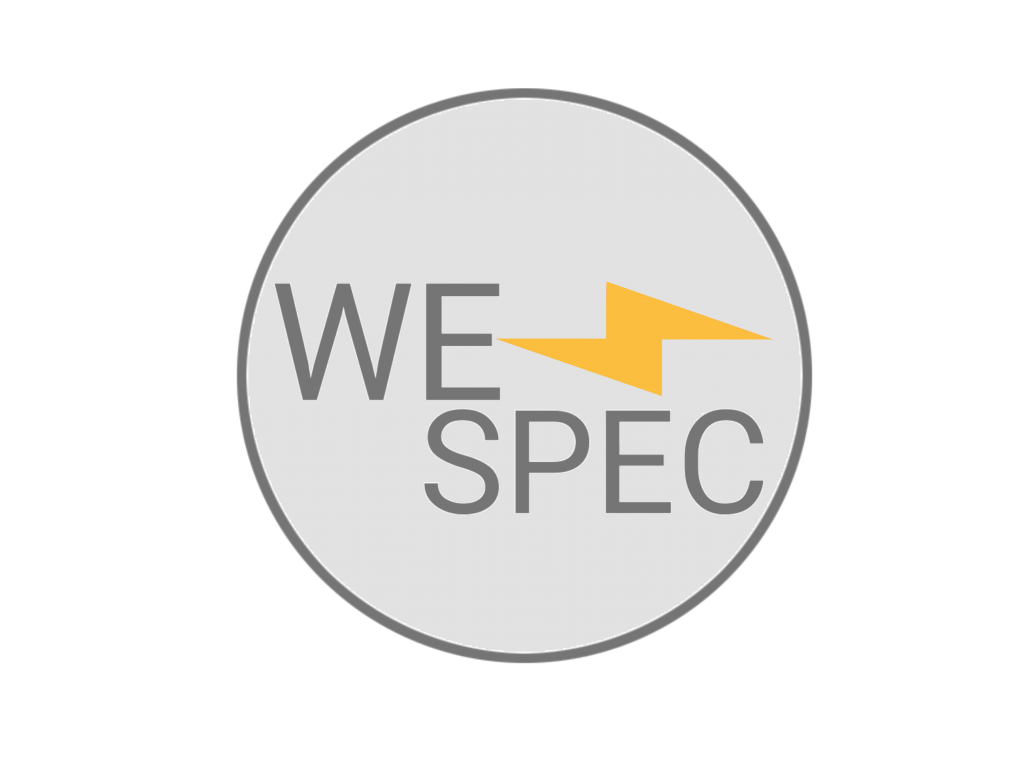Development of New Welding Materials on the Base of Mathematical Modeling of Metallurgical Processes
Part1.Phase Interaction Analysis and Development of the Basic Model
M.Zinigrad , V. Mazurovsky
Introduction
The development of new electrode coating compositions is the topical area in the current research, especially when we consider such problems as the welding of special-purpose steels and alloys, built-up layers with special properties, or specific maintenance works. The brief review of currently existing calculation techniques for electrode coating compositions demonstrates that they are based on the experimentally deduced dependence which allows to calculate the chemical composition of built-up metal (weld metal) using so called transition coefficients (Ref. 21) or assimilation coefficients (Ref. 22) In some cases the attempt is made to take into consideration some redox reactions in the welding zone (on molten metal-slag boundary in the welding pool) (Ref. 21, 23). Usually, however, the composition of built-up metal is calculated using the mixture method without taking into consideration physico-chemical processes in the welding pool (Ref. ? ). This approach can be appropriate in order to forecast the chemical composition of built-up metal or to calculate electrode coating for the welding of low-alloy steel and carbon steel, but leads to erroneous results for high-alloy steel and alloys or for built-up layers with special properties. In the latter case the considerable amount of experimental work can be required in order to develop the new composition of electrode coating which can take months or even years.
During the last decade both the increasing potential and the availability of personal computers opened new possibilities for the solution of the above-mentioned problems, and along with it we can consider the computer modeling of physico-chemical processes in the reaction zone connected with technological parameters of the welding process. Computer modeling used now for industrial chemical processes study and for the analysis of real technologies allows us to decrease the amount of time and the amount of labor needed for the research, as well as makes it possible to carry out experiments which cannot be performed or can be performed only with great difficulty on a real object. The development of computer technology and its accessibility have made it possible to solve problems for which there were previously no known methods of solution or these methods were so tedious that they proved to be unsuitable for the practical application. Computer approach is especially valid for physicochemical processes since their complexity stems from the simultaneous occurrence of a considerable number of physical and chemical processes involving liquid, solid, and gas phases, as well as the high temperatures, the complex character of the hydrodynamic and heat fluxes, and the nonstationary nature of the processes. This complexity is manifested in the large number of parameters determining the course of the processes and in the fact that the variation of a few parameters causes the variation of many others. Such complex physicochemical objects are studied by constructing models, i.e., simplifying systems, which reflect the most significant aspects of the object under consideration.
Computer Modeling as an Up-to-date Approach to New Welding Materials Development
One of the most promising directions of physicochemical objects computer modeling is the usage of these models for welding technologies analysis which is represented in (Ref. 1-19). The first stage of this modeling is generally thermodynamic models construction. This stage is very important both for ascertaining the fundamental possibility of the combined occurrence of particular chemical processes and for listing the most important thermodynamic characteristics. If the rates of the chemical reactions are sufficiently high, the composition of the reactant mixture at the outlet of the chemical reactor should be fairly close to the equilibrium composition and can be found by thermodynamic methods. There are several approaches to the creation of thermodynamic models. They include the employment of polymer theory to model complex multicomponent systems, modeling for the purpose of constructing phase diagrams, the construction of statistical thermodynamic models, the determination of the enthalpy and other thermal characteristics, the modeling of melting processes and structure-building processes.
When there are no or only few theoretical data on the process being modeled, the mathematical description can take the form of a system of empirical equations obtained from a statistical study of the real process.
A correlation between the input and output parameters of the object is established as a result of such a study. Naturally, the employment of statistical models is restricted by the width of the range of variation of the parameters studied.
In recent years mathematical modeling has been applied not only to the investigation of theoretical aspects of physicochemical processes but also to the analysis of actual technologies.
The areas of the prediction and optimization of the composition and properties of materials obtained in different technological processes are especially promising (Ref. 1-4, 17). Some of the results were obtained from the modeling of the process of the formation of a weld pool (Ref. 1), from the modeling of weld metal transformations (Ref. 18, 19), and from the modeling of processes involving the segregation of nonmetallic inclusions in steel, the interaction of particles during welding (Ref. 4), and diffusion-controlled kinetics (Ref. 2, 16, 17).
Important results were obtained from the studies of the physical and chemical parameters of welding processes (Ref. 16) and development of kinetic model of alloy transfer (Ref. 17).
By determining the chemical composition of the weld metal researchers have developed the kinetic model (Ref. 17) Basing on this model the authors described the transfer of alloying elements between the slag and the metal during flux-shielded welding. The model also takes into consideration the practical welding process parameters such as voltage, current, travel speed, and weld preparation geometry. The model was tested experimentally for transfer Mn, Si, Cr, P, Ni, Cu, and Mo.
In our opinion the problem of modeling complex objects with consideration of the kinetics of the chemical processes occurring them is more complicated.
This applies both to diffusion processes (Ref. 17) and especially to the analysis of the kinetics of complicated heterogeneous reactions.
A more complete, adequate description of actual chemical processes requires the construction of a mathematical model which takes into account the diffusion of all the components in the complex multi-component system, the kinetics and mechanism of the individual chemical reactions, the special features of their simultaneous occurrence, and the influence of heat transfer and the hydrodynamics, as well as the influence of the engineering parameters and other factors. There is presently a large amount of experimental and theoretical data, which make it possible to solve such problems.
The present research is also intended to be devoted to the development of mathematical models of such a type on the basis of a new method for the kinetic analysis of reactions in multicomponent systems.The main problem which the technologies cited solve is the production of deposited metal (welds, coatings, etc.) with a required composition and assigned properties. At present time, these problems are generally solved empirically, i.e., either by means of technological experiments or by the statistical treatment of existing experimental data.
Such an approach requires great expenditures of time and resources and the consumption of considerable amounts of expensive materials.In addition, the results of such researches have a random character and are far from optimal.
Peculiarities of Proposed Approach, Objects , and Stages of the Research
The approach employed in the present research fundamentally different from the above mentioned ones. The mathematical model of the physicochemical processes developed and the computer program written on its basis will make it possible to “run” a large number of variants within a short time without considerable expenses and to select the optimal variant, which provides products with the required composition and properties. Such a result cannot be obtained, in principle, even after the performance of hundreds of technological experiments.
The use of such a program permits to investigate the possibility of replacing expensive metallic components metal- and oxide-containing industrial waste products, something which is practically impossible to do under the empirical approach.
In the most welding materials the expensive components are generally used. Such as ferroboron, ferrochrome, ferromolibdenum, ferrotitanium, ferrotungsten, ferrovanadium, ferrosilicon, etc., and pure metallic and oxide powders.
The cost of these components is usually greater then the cost of other raw materials such as electrode rods (in case of most manual welding) or steel band in case of flux cored welding processes. Therefore, the replacement of expensive components with industrial waste products saves considerable consumption of these expensive materials.
The research is carried out in three stages: 1) mathematical description of the process being studied, i.e., construction of the mathematical model; 2) development of an algorithm for solving the problem, i.e., a procedure for determining the numerical values of the output parameters; 3) establishment of the equivalence of the model to the process being studied. Special attention was focused on the stage of constructing the model, which was based on a thorough analysis of the physicochemical essence of the phenomena being described and on constructing based on the model computer program.
From these considerations the following problems of the work were defined:
- to develop a mathematical model of industrial welding processes on the basis of a thermodynamic and kinetic analysis of the metallurgical processes, involving the metal, slag, and gas;
- to use the model and the computer program, written on its basis, to optimize welding technologies employing coated electrodes;
- to optimize the composition of electrode coatings which produce welded joints with the preset composition;
- to develop a fundamentally new class of electrodes, which coating contain industrial waste products instead of expensive components.
The object of modeling for the analysis of the physicochemical processes, taking place during welding, is a system which includes the following phases: metal, oxide melt (slag), gas, and solid phases, in which various chemical and physical processes take place.
Phase Interaction Analysis
Metal-slag interaction in the process of arc welding exerts a substantial impact on the chemical composition of built-up metal (weld metal) which ultimately determines the working characteristics of weld metal or built-up layer. The consideration of this interaction in the process of electrode coating development which can ensure the preset composition of weld metal is based on the mathematical modeling of the welding technological process, taking into account the following features of the process:
- metal-slag interaction at two consecutive stages – electrode (drop) and welding pool – which differ in temperature, geometrical and hydrodynamic parameters;
- continual renewal of interacting phases (molten metal and slag) at each stage through the melting and crystallization of base and adding materials;
- simultaneous occurrence of all reactions at each stage and their interplay.
Since it is impossible to built a model describing a process with the absolute adequacy, we offer some assumptions and simplifications. Thus in the model under consideration basing on the experimental data for the stationary welding conditions the following assumptions were made:
- within the phases under consideration there are not any gradients of chemical potential (the ideal mixing of phases);
- while considering the interaction between gas and slag phases we take into account only the reactions with hydrogen and nitrogen;
- metal-slag reactions surfaces for each stage are kinetically homogeneous.
Figure 1 is a scheme showing the interaction of phases with regard to these assumptions.
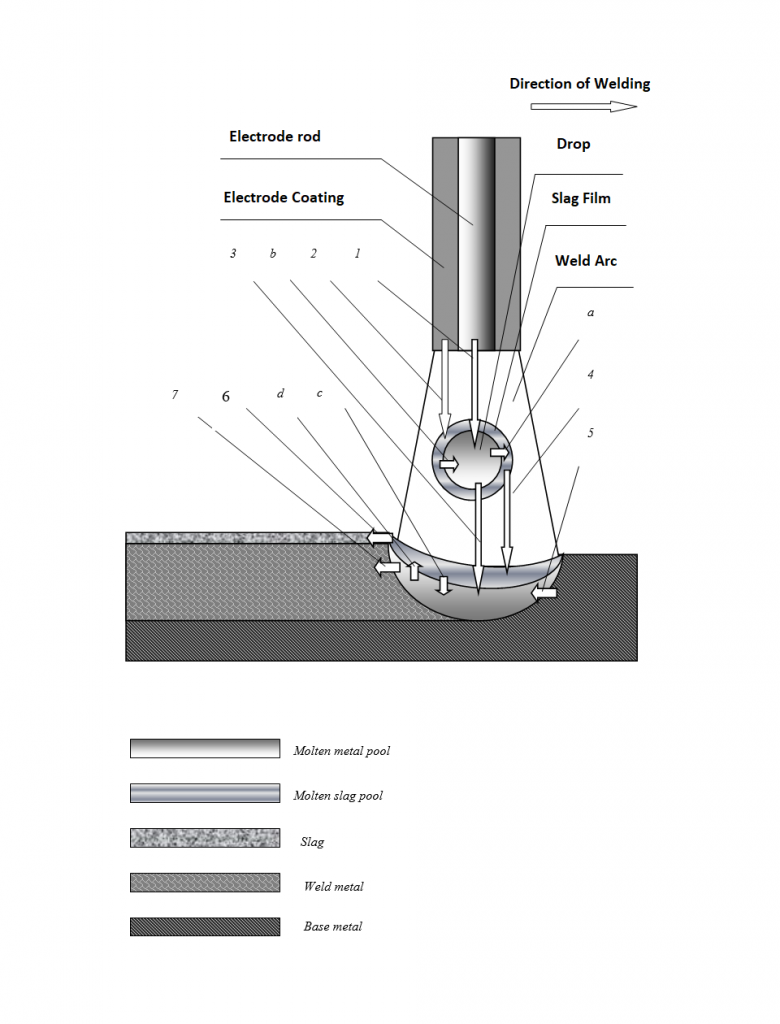
On the scheme figures denote the direction of material transfer, and letters denote the interaction of phases:
1 – melting of the electrode rod and formation of a drop;
2 – melting of the electrode coating and formation of slag film over the drop;
3 – transfer of the drop metal (which has reacted with slag film at the stage of transfer) to the metal pool;
4 – transfer of the slag film (which has reacted with the drop metal at the stage of transfer) to the slag pool;
5 – melting of base metal;
6 – crystallization of slag pool;
7 – crystallization of metal pool;
a, b – redox reaction at the slag-metal boundary in a welding drop;
c, d – redox reaction at the slag-metal boundary in a welding pool.
Development of the Basic Model
The welding process has a stage-like character, and it goes without saying. It should be only specified that the stage of electrode melting as well as the existence of the drop are of considerable importance. At this stage we already observe that the reactions of interaction between phases exert considerable effect on the changes in the chemical composition of molten metal and slag incoming to the welding pool, for which pool they provide the starting chemical composition of incoming electrode metal and slag. Regardless of the process stage and phase type the material balance of elements can be described by the following equation:
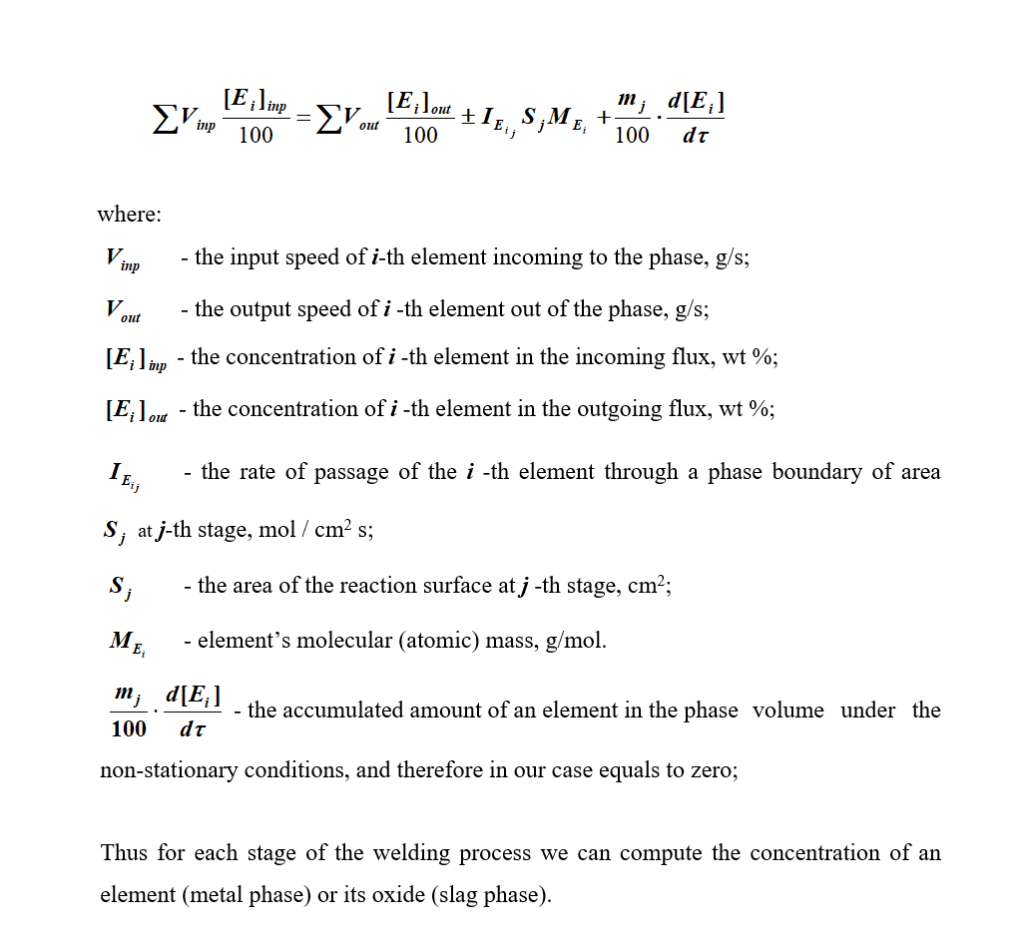
The Stage of Electrode Melting (the electrode drop)


The Stage of the Pool

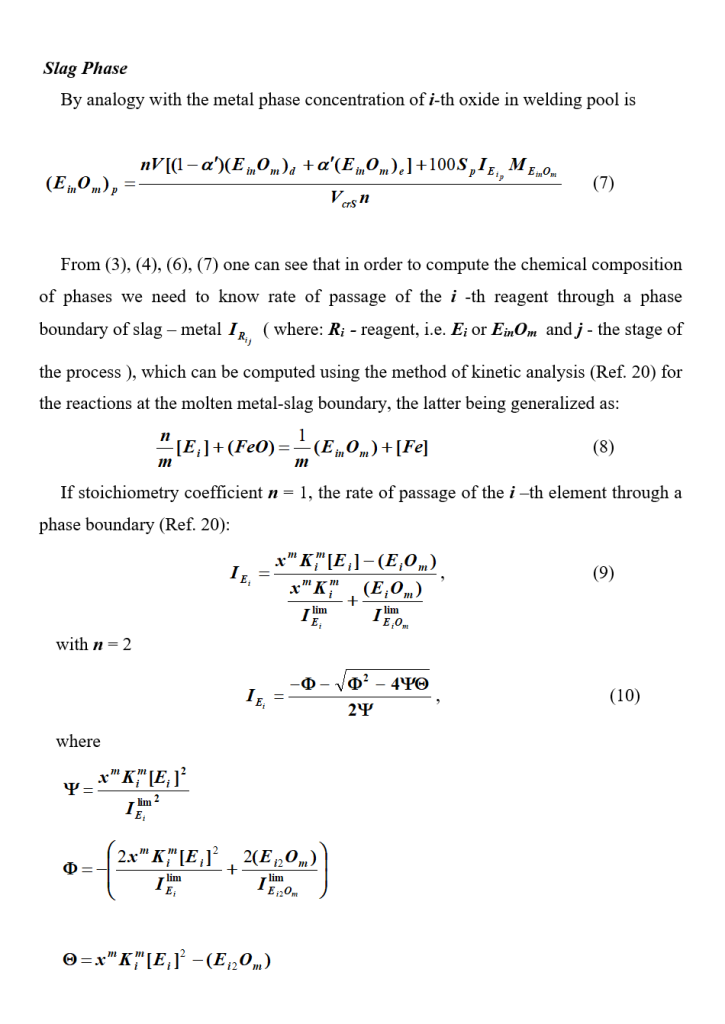
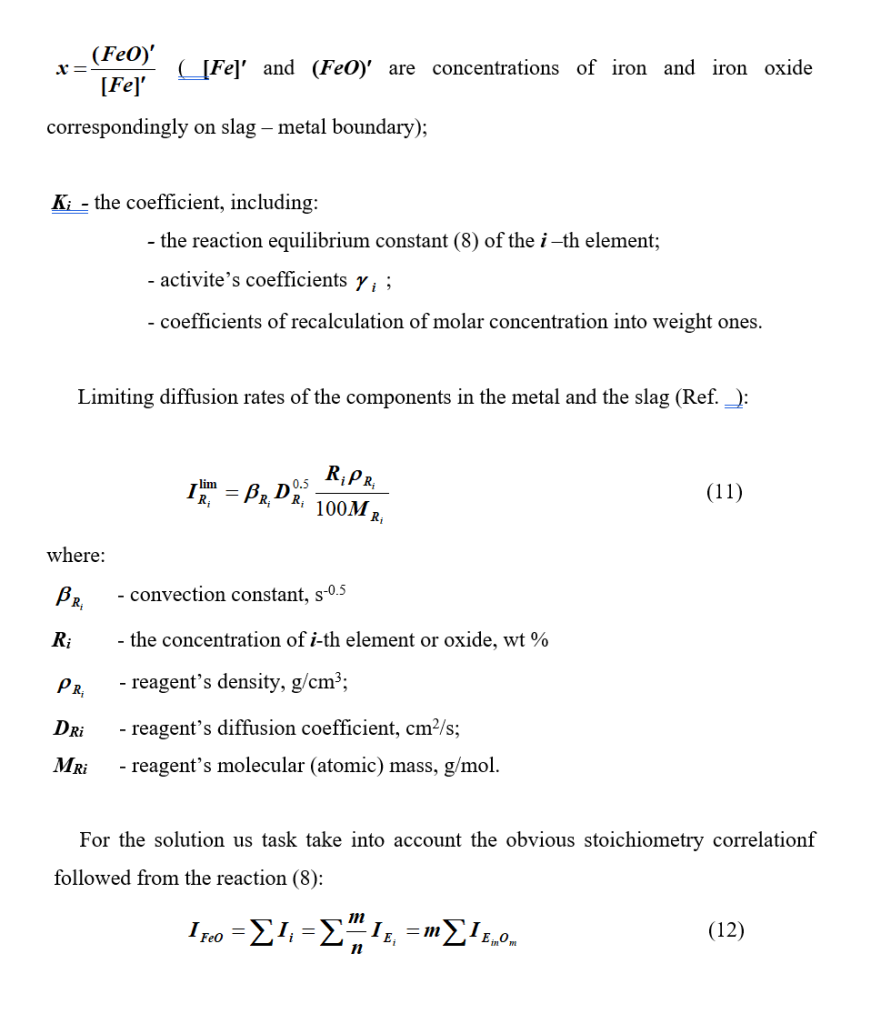
The system of the above equations (3,4,6,7,10,12) presents the general mathematical model of physico-chemical processes of the manual metal arc welding.
In actual practice the solution of this problem allows to compute the chemical composition of built-up metal provided that we know the electrode formula and the type of base metal. Rather often, however, we are faced with the inverse problem when it is necessary to compute such an electrode formula that can give us the required chemical composition of built-up metal in the process of welding (or building-up) of specific metal (hereafter, “the opposite problem”).
The computation is based on the above model. The initial stage of the solution (the preliminary computation) determines the initial formula of an electrode. Using it as a base one can easily compute the chemical composition of built-up metal and forecast its properties. If the results of this computation do not satisfy the verification criteria, then appropriate corrections are introduced into the initial formula whereupon it becomes “the intermediate formula”. The computation is repeated, and the results are again checked. This procedure is repeated until (after n iterations) the desirable results are gained and the final formula of an electrode is obtained.
Conclusion
The mathematical model of welding technology process on the basis of the kinetic analysis method [20] had been developed.
The model takes into consideration:
- stage-by-stage implementation of the welding process;
- continuous renovation of interacting phases;
- simultaneous running of all reactions and their mutual influence;
- physico-chemical properties of the interaction phases;
- hydrodynamic conditions of the welding process;
- interconnection between welding process parameters (welding conditions) and kinetics of reactions.
The proposed method can be applied to the development of new compositions of welding materials (electric coatings, flux cored wires, welding fluxes). The practical implementation of this approach is considered in Part 2.
Know-More

